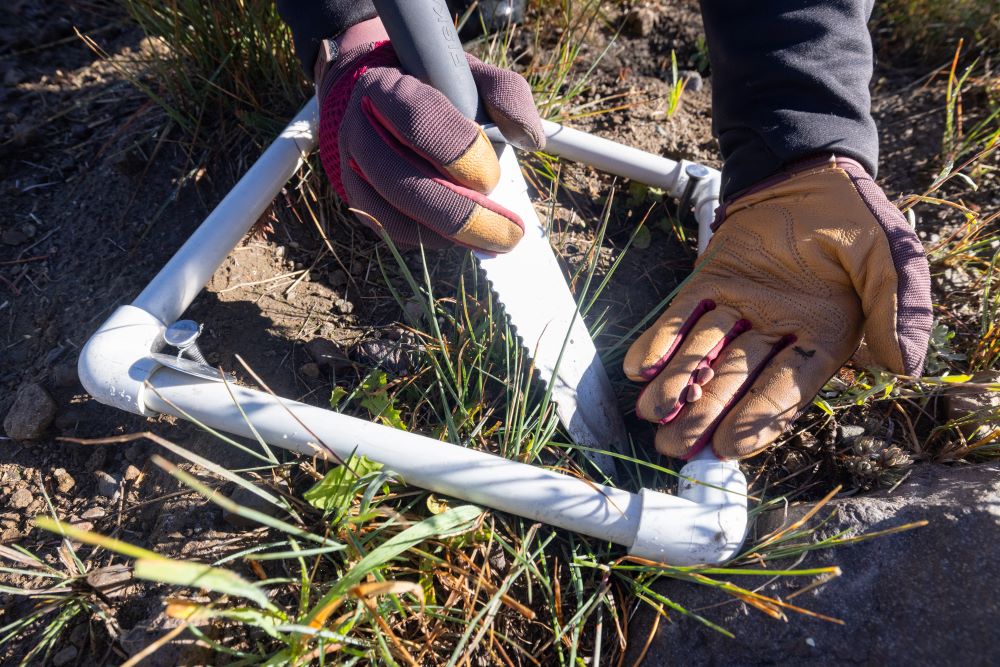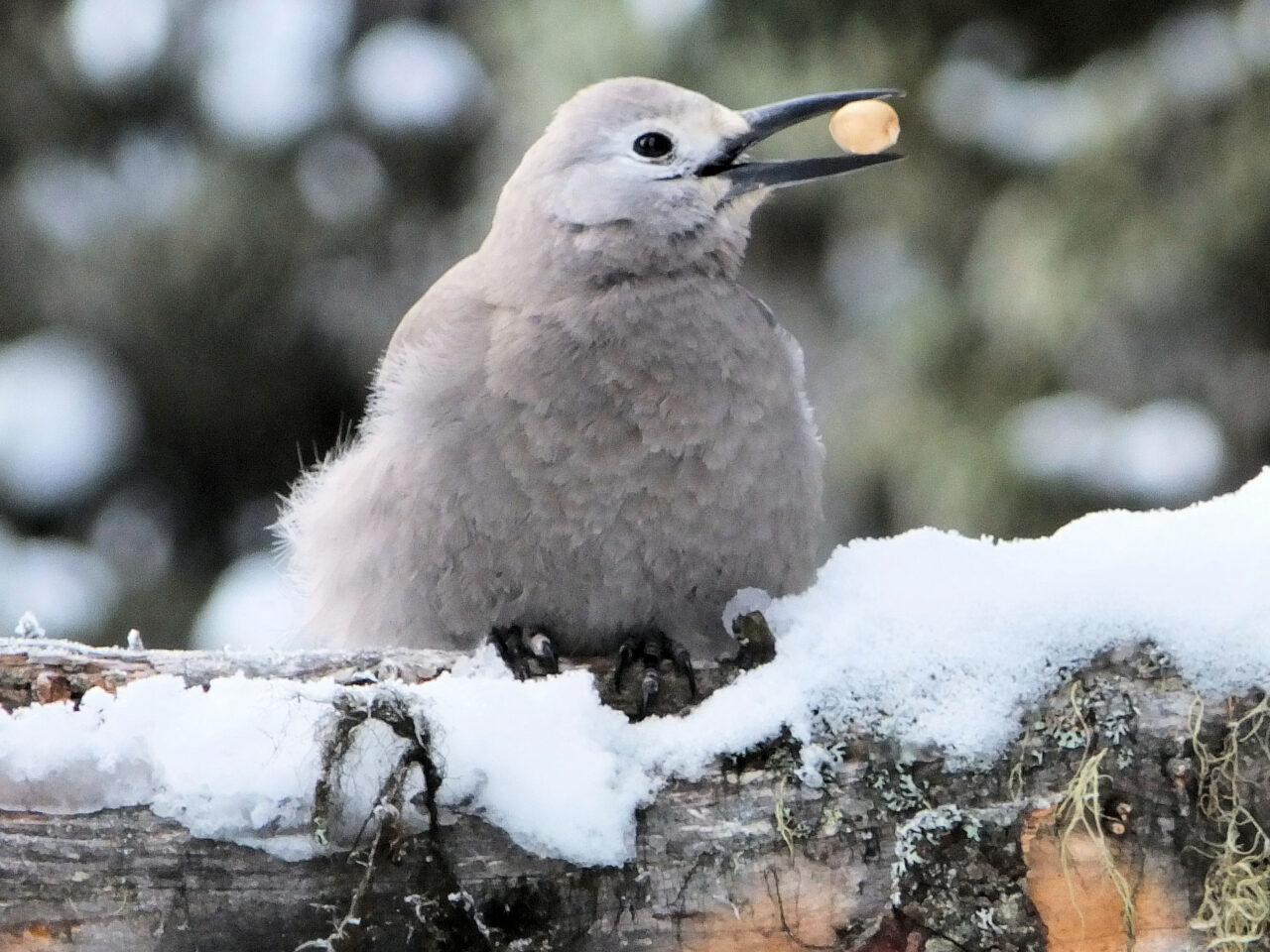
Photo Credit: Jacob W. Frank / National Park Service

Photo Credit: Jacob W. Frank / National Park Service
IN AN OPEN MEADOW on the side of Mount Washburn in Yellowstone National Park, Samantha Higgins, a biological science technician with the National Park Service, crouches next to a 9-by-9-inch PVC pipe frame. Using a small knife tool called a hori-hori, she scratches into the ground about 2 inches to create an opening. She deposits two brown seeds — each the size of a small kernel of corn — and pinches the soil together before moving to the next site.
In this way, Higgins imitates the Clark’s nutcracker, an ashy grey bird with a penchant for plucking whitebark pine seeds from their tightly wound cones and depositing them into caches around the landscape.
While the nutcracker may intend to return for its high-calorie snack, the caches are so scattered and numerous that many seeds are forgotten. Some of these stragglers germinate — spawning a new generation of whitebark pine trees. In nature, it is only through the Clark’s nutcracker’s seed distribution that whitebark pine reproduces.
Old whitebark pine and meadows surround Higgins and her cache. The standing dead snags tell the stories of a mix of disturbances the park has experienced over the decades: wildfires, mountain pine beetles and white pine blister rust. The latter is an invasive fungus that slowly throttles whitebark pine and has become its greatest threat in recent years. These stressors have contributed to the decline of whitebark pine across its range. In December 2022, it was registered as threatened under the Endangered Species Act.
Beyond the trees are the rolling hills of Yellowstone, where healthy and regenerating forests of spruce and fir overlook spectacular vistas. Chipmunks and squirrels scurry across logs and debris. Bison occasionally wander through the clearing. And Clark’s nutcrackers are everywhere, harvesting whitebark pine and conducting their fall ritual of creating seed caches in preparation for winter.

Photo Credit: Keith Roper
“Everything is alive this time of the year. It is a very lively ecosystem,” says Elizabeth Pansing, director of forest and restoration science for American Forests.
It’s an area Pansing knows well. She conducted much of her doctoral field work around Mount Washburn. But her interest in the present activities really stems from her master’s research on direct seeding.
Whereas typical planting methods rely on 2-year-old seedlings that have been grown in a nursery, direct seeding is a restoration method that involves planting whitebark pine seeds directly into the ground
In 2012 through 2018, Pansing conducted a large trial of direct seeding under the guidance of her advisor, Diana Tomback, through the University of Colorado, Denver. The initial results suggested this method may offer a potential alternative to planting whitebark pine seedlings in remote areas.
TESTING DIRECT SEEING ON A NATIONAL PARK SCALE
Hillary Robison, deputy chief for the Yellowstone Center for Resources with Yellowstone National Park, became interested in Pansing’s direct-seeding work after the two spoke on a panel in early 2023.
White pine blister rust has been particularly damaging for the surrounding Greater Yellowstone Ecosystem, which includes Yellowstone and Grand Teton National Parks. There, 20 years of monitoring have found 34% of mature whitebark pine are infected with blister rust. Recent restoration efforts have focused on replanting whitebark using seedlings grown from seeds sourced from parent trees with demonstrated genetic resistance to white pine blister rust. Robison saw the potential to build on Pansing’s research and test the effectiveness of direct seeding disease-resistant seeds in remote areas of the park.
“The research by Dr. Pansing and Dr. Tomback shows that direct seeding works,” Robison says. “So, we wanted to take that to the next level and see if it works at scale.”

Photo Credit: C.J. Adams / National Park Service
Whitebark pine habitat is notoriously difficult to access, with stands often growing in rocky high-elevation areas. According to Laura Jones, branch chief of vegetation management with Grand Teton National Park, direct seeding can make it easier to access these remote locations by eliminating the need for transporting large, bulky quantities of seedlings.
“Hiking in takes people and energy,” Jones says. “When we start to talk about bringing in seedlings, you’re bringing in the weight of the seedlings and the soil, so getting them to their destination isn’t as easy. The tools to get them in are heavier, because you need to dig bigger holes for seedlings. You start looking at needing helicopters to get your gear up there.”
In comparison, on a recent site visit near Amphitheater Lake, Jones and technicians carried 2 pounds of seed — exactly 7,132 seeds — 3 miles into the back country, a 3,000-foot elevation gain.
“It potentially opens up massive tracts of land that would otherwise not be considered for reforestation or planting,” Pansing says.
There are other benefits to direct seeding too, including the ability to harvest and plant seeds quickly. Pansing says seeds from cones collected in the fall can be processed and planted by the following summer, as opposed to waiting for seedlings to grow in a nursery first. Additionally, Jones points out that the digging involved in direct seeding creates less environmental disturbance compared to planting seedlings.
“Planting a seed 1 inch into the ground is kind of a minimalist approach in a way,” Jones says. “That has appeal for human resources, financial resources and other values you have in the park and in the wilderness.”

Photo Credit: C.J. Adams / National Park Service
Jones is one of many land managers from national parks across the American West who Robison recently led to create a five-year master agreement funded by the 2022 Inflation Reduction Act. The agreement enables the parks to work with American Forests on a variety of whitebark pine restoration projects, including seed collection, genetic testing and planting.
“We decided this was an innovation we wanted to try. Having an opportunity like this is really a windfall for parks,” Robison says.
For Yellowstone, Grand Teton and Glacier National Parks, the focus for now is direct seeding. This year, direct seeding trials began in Yellowstone and Grand Teton, where technicians planted more than 2,600 caches total. Seeding is expected to occur in Glacier in the next year.
AN EXPERIMENT IN RESTORATION
Direct seeding won’t replace seedling planting, but Pansing hopes it will become a complimentary tool for reforestation.
“The potential benefit of this is giant, if it works. We’re in the first stage where we’re trying to assess its efficacy and whether it’s another tool to put into the whitebark pine restoration toolkit.” — ELIZABETH PANSING, DIRECTOR OF FOREST AND RESTORATION SCIENCE AT AMERICAN FORESTS
For now, the method is still experimental.
Planting site selection is determined by the National Whitebark Pine Restoration Plan, a science-informed strategy recently developed to guide restoration of whitebark pine across the United States portion of its range. The plan identifies core areas where conservation and restoration should take place, with the expectation that as restored populations mature and bear cones, Clark’s nutcrackers will aid further recovery by dispersing seeds beyond the core areas.
The technicians use maps showing randomly selected locations to plant caches, to which they navigate using GPS.
“In order to make this inferentially sound, we need to randomly select locations in this core area,” Pansing says.
Pansing and the team are also comparing the outcomes of direct seeding in different conditions to better understand what types of sites are optimal for a seed to germinate and survive. Some of the seeds are planted next to stumps, rocks or trees — microsites that offer protection from the wind and other elements. Other seeds are planted in open areas.
Some of the planting locations are marked so the researchers can later return and monitor any growth. Eight-inch nail spikes driven into the ground on either side of the PVC pipe frame mark where the seeds have been deposited. Those nails remain, and the location is marked using GPS. Year after year, the researchers can return to the site and fit the PVC frame over the nails to monitor any development that has occurred.
Success may not be immediately observable. Whitebark pine is known for delayed germination. Seeds can stay dormant in the ground for as long as 9 years. Once a seed germinates, it will emerge an inch or two tall, with a small stem and vibrant coloring ranging from purple to green. Seven to nine fledgling needles will curl up into a bowl shape, from which the growth will emerge.
By gathering data during annual monitoring visits, Pansing, Robison and Jones will hone in on best practices for direct seeding.

Photo Credit: C.J. Adams / National Park Service
“It will take some additional trial and error to understand better,” Jones says. “This happens across ecological restoration and it’s why monitoring is so important.”
Pansing already made note of one change she’ll make to the methodology after observing Clark’s nutcrackers, squirrels and chipmunks actively moving around the landscape in pursuit of seeds.
“There are more small animals pilfering and caching ripe whitebark pine seeds this time of the year in preparation for winter,” Pansing says. “In future years, if we do the direct seeding earlier in the season, I suspect we’ll see less of our cached seed stolen by animals.”
Liane O’Neill writes from Portland, Ore., and serves as American Forests’ senior brand manager for Resilient Forests.